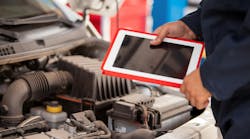For years, the quick lube industry has referred to the employees on the shop floor as “technicians,” and today employing the latest “tech” is increasingly a major part of the job description. Even shops that have remained fairly “old school” are finding that technology and software can be incorporated to help streamline numerous processes and further encourage innovative productivity.
“Technology today has helped to streamline every aspect of our industry,” says Kye Grisham, director of purchasing and automotive technology for the Christian Brothers Automotive Corporation, which now utilizes a completely online point-of-sale (POS) system, digital vehicle inspections, online service information, and online appointment schedulers, while it also has support teams to assist with remote diagnostics and programming.
The High-Tech Shop of Today
Tablets, apps, and other digital tools aren’t part of the shop of tomorrow—they’re critical for the successful shop of today. The right use of technology can keep more than the lubes flowing, and it is something that is almost expected by many customers who demand fast service and a clear understanding of what services were provided.
“From the initial greeting of the customer, writing the repair order, all the way to working on the vehicle has been affected positively from different technologies,” Grisham tells NOLN. “Most of the software and applications used today have helped to shorten service time in the bay. With online point-of-sales, web-based digital inspection, and all web-based service information, the efficiency of shops today has overwhelmingly surpassed shops not utilizing these technologies.”
Moreover, digital repair manuals, data-driven software for repairs, and predictive maintenance are able to schedule and service vehicles a lot quicker.
There was a time when even adding a printer to a business required a visit from an IT specialist, but today’s software has been designed to be far more “user friendly,” while compatibility issues are also largely a thing of the past.
“With some of the software on actual computers you may run into this but with the majority of everything we use, we do not run into this issue,” notes Grisham. “We do utilize a lot of the OE diagnostic software and some of those cannot run on the same drive and/or partition.”
Adapting to the New Technology
While many of today’s newer employees are of Generation Z and practically grew up with tablets and smartphones permanently affixed to their hands, the change to new technology can present challenges for some more “seasoned” technicians on the shop floor.
Grisham says that this is becoming less common, and most technicians have evolved with the technology and understand that they must continue learning to stay on pace. In fact, many of the programs are designed to be intuitive.
“There are still some with hesitation but they have been left behind and continue to just work on older vehicles. The ones that evolved have learned that this technology helps them improve efficiency, increase knowledge, and expand their opportunity,” explains Grisham.
“We just need to take time to show them how this can have a positive effect on their career and the work they do,” he adds. “With all the advancements in vehicle technology, there is adequate training available through multiple resources to stay on top of this.”
The Evolving Tool Bench
It isn’t just the technicians that have evolved as technology increasingly has found a place in many shops. On today’s tool bench, it is now increasingly common to find tablets and other small devices alongside wrenches and screwdrivers.
“This is absolutely true,” says Gregg Rainville, chief revenue officer at Steer by Mechanic Advisor. “Many shops now provide digital inspection, and that requires a camera—so we’re seeing technicians employ tablets provided by the shop, but in many cases, they can use their iPhone and the apps. The Steer platform is very mobile friendly.”
Steer by Mechanic Advisor can also integrate marketing efforts and maintain reputation management, where customer reviews are tracked, while further providing customers with reminders when their vehicles could require upcoming service.
Such technology can then help shops provide the customer with a greater understanding of what services may need to be done, but the same software can also ensure that the technicians literally have access to all the necessary information to accomplish a job without leaving the shop floor.
“We use digital vehicle inspections to show the customer all the items on their vehicle that are part of our inspection process,” says Grisham. “We use video and pictures to illustrate, and the technicians need a tablet to help with this. Along with that, most techs now use tablets to look up service information, repair orders, and anything relevant to the vehicle. The majority are using tablets over computers when possible.”
Connecting With Customers Post-Visit
In addition to streamlining the service of a vehicle, the latest technology can further enhance the connection to customers following a visit. This can ensure that they are satisfied with the service they received, and more importantly, even address and resolve any potential problems.
“We are seeing that customers can provide a lot of insightful feedback, which can help undercover bottlenecks—while at the same time, technology can streamline the reviews and feedback they might leave,” Rainville tells NOLN.
This can enable a shop to be equal parts reactive and proactive when it comes to developing lasting relationships with customers.
Security Is Still a Consideration
Many shops may have reservations about adapting too much technology or relying on apps and software given that not a week goes by without the news warning of the next threat from hackers and the latest issues or glitches with computer networks. However, these risks too can be mitigated, while Rainville says that security is already top of the mind with the Steer platform.
“Most of the programs are on Amazon Web Services, where everything is encrypted and protected, and the software makes clear that we’re not selling or otherwise using customer data,” adds Rainville.
In the end, technology shouldn’t be a hurdle—and instead, it should be seen as an opportunity that can streamline processes and provide a greater level of interaction with the customer.
“We’re seeing that customers practically expect this level of technology,” Rainville emphasizes. “Everyone should be looking at their business and determine how this technology can make the job easier.”





